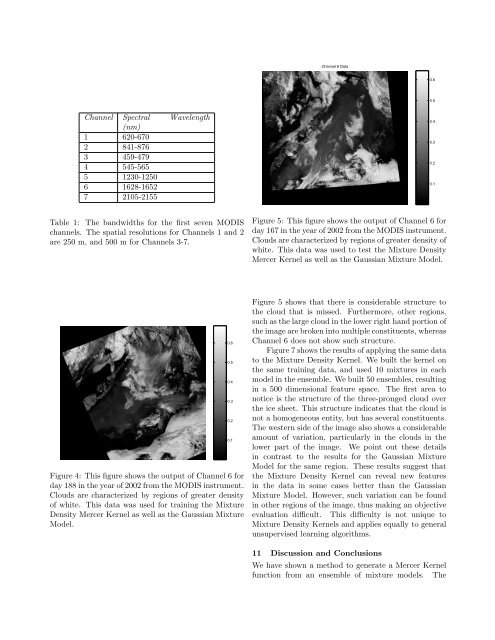Mixture Density Mercer Kernels - Intelligent Systems Division - NASA
Mixture Density Mercer Kernels - Intelligent Systems Division - NASA
Mixture Density Mercer Kernels - Intelligent Systems Division - NASA
You also want an ePaper? Increase the reach of your titles
YUMPU automatically turns print PDFs into web optimized ePapers that Google loves.
Channel 6 Data0.60.5Channel Spectral Wavelength(nm)1 620-6702 841-8763 459-4794 545-5655 1230-12506 1628-16527 2105-21550.40.30.20.1Table 1: The bandwidths for the first seven MODISchannels. The spatial resolutions for Channels 1 and 2are 250 m, and 500 m for Channels 3-7.Figure 5: This figure shows the output of Channel 6 forday 167 in the year of 2002 from the MODIS instrument.Clouds are characterized by regions of greater density ofwhite. This data was used to test the <strong>Mixture</strong> <strong>Density</strong><strong>Mercer</strong> Kernel as well as the Gaussian <strong>Mixture</strong> Model.Figure 4: This figure shows the output of Channel 6 forday 188 in the year of 2002 from the MODIS instrument.Clouds are characterized by regions of greater densityof white. This data was used for training the <strong>Mixture</strong><strong>Density</strong> <strong>Mercer</strong> Kernel as well as the Gaussian <strong>Mixture</strong>Model.0.60.50.40.30.20.1Figure 5 shows that there is considerable structure tothe cloud that is missed. Furthermore, other regions,such as the large cloud in the lower right hand portion ofthe image are broken into multiple constituents, whereasChannel 6 does not show such structure.Figure 7 shows the results of applying the same datato the <strong>Mixture</strong> <strong>Density</strong> Kernel. We built the kernel onthe same training data, and used 10 mixtures in eachmodel in the ensemble. We built 50 ensembles, resultingin a 500 dimensional feature space. The first area tonotice is the structure of the three-pronged cloud overthe ice sheet. This structure indicates that the cloud isnot a homogeneous entity, but has several constituents.The western side of the image also shows a considerableamount of variation, particularly in the clouds in thelower part of the image. We point out these detailsin contrast to the results for the Gaussian <strong>Mixture</strong>Model for the same region. These results suggest thatthe <strong>Mixture</strong> <strong>Density</strong> Kernel can reveal new featuresin the data in some cases better than the Gaussian<strong>Mixture</strong> Model. However, such variation can be foundin other regions of the image, thus making an objectiveevaluation difficult. This difficulty is not unique to<strong>Mixture</strong> <strong>Density</strong> <strong>Kernels</strong> and applies equally to generalunsupervised learning algorithms.11 Discussion and ConclusionsWe have shown a method to generate a <strong>Mercer</strong> Kernelfunction from an ensemble of mixture models. The
















